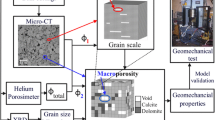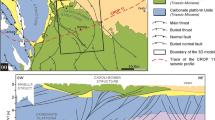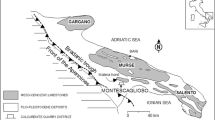Abstract
Rock mass classification and geomechanical models have a particular importance for carbonate rocks, due to their peculiar fabric, variability of the main features, and scarce availability of experimental data. Carbonates are particularly sensitive to syn-depositional and post-depositional diagenesis, including dissolution and karstification processes, cementation, recrystallisation, dolomitisation and replacement by other minerals. At the same time, as most of sedimentary rocks, they are typically stratified, laminated, folded, faulted and fractured. The strength and deformability of carbonate rock masses are, therefore, significantly affected by the discontinuities, as well as by their pattern and orientation with respect to the in situ stresses. Further, discontinuities generally cause a distribution of stresses in the rock mass remarkably different from those determined by the classical elastic or elasto-plastic theories for homogeneous continua. Goal of this work is the description of the difficulties in elaborating geomechanical models to depict the stress–strain behavior of karstified carbonate rock masses. Due to such difficulties, a high degree of uncertainty is also present in the selection of the most proper approach, the discontinuum one or the equivalent continuum, and in the numerical model to be used within a specific engineering application as well. The high uncertainty might cause wrong assessments as concerns the geological hazards, the design costs, and the most proper remediation works. Even though recent developments in the application of numerical modeling methods allow to simulate quite well several types of jointed rock masses, as concerns carbonate rock masses many problems in representing their complex geometry in the simulation models still remain, due to peculiarity of the structural elements, and the presence of karst features. In the common practice, the improper use of the geomechanical models comes from a superficial geological study, or from the lack of reliable geological and structural data that, as a consequence, bring to erroneous evaluations of the influence of the geological-structural features on the in situ stress state and the stress–strain rock mass behavior.









Similar content being viewed by others
References
Andriani GF, Tropeano M (2009) Modello geologico e coltivazione di materiali naturali da costruzione: l’esempio delle calcareniti plio-pleistoceniche a Matera. Rend online Soc Geol It 6:15–16
Andriani GF, Parise M, Diprizio G (2015) Uncertainties in the application of rock mass classification and geomechanical models for engineering design in carbonate rocks. In: Lollino G, Manconi A, Guzzetti F, Culshaw M, Bobrowsky P, Luino F (eds), Engineering Geology for Society and Territory, vol 5. Urban Geology, Sustainable Planning and Landscape Exploitation. Springer, ISBN: 978-3-319-09047-4, pp 545–548
Barla G, Barla M (2000) Continuum and discontinuum modelling in tunnel engineering. Gallerie e Grandi Opere Sotterranee 61:15–35
Barla G, Chiappone A, Scavia C (1989) Anisotropia di resistenza delle rocce in condizioni di compressione triassiale. Rivista Italiana di Geotecnica 3:105–120
Barton N, Lien R, Lunde J (1974) Engineering classification of rock masses for design of tunnel support. Rock Mech 6(4):189–236
Barton N, Lien R, Lunde J (1975) Estimation of support requirement for underground excavation. In: Proceedings of 16th US Symp Rock Mech, University of Minnesota, pp 163–178
Bieniawski ZT (1973) Engineering classification of jointed rock masses. Tran S Afr Inst Civ Eng 15:335–344
Bieniawski ZT (1974) Geomechanics classification of rock masses and its application in tunnelling. Proc 3rd Int Congr Rock Mech. Denver 2A:27–32
Bieniawski ZT (1993) Classification of rock masses for engineering: the RMR system and future trends. In: Hudson JA (ed) Compressive rock engineering, 3rd edn. Pergamon Press, Oxford, pp 553–573
Bock S (2014) Numerical modelling of a void behind shaft lining using FDM with a concrete spalling algorithm. J Sustain Mining 13(2):14–21
Brady BHG (1992) Stress Analysis for Rock Masses. Bell FG. Engineering in Rock Masses, Butterworth-Heinemann Ltd, Oxford, pp 117–133
Crea G, Martino D, Ribacchi R (1981) Influenza delle caratteristiche strutturali sull’anisotropia delle rocce. RIG 14(4):235–260
Culshaw MG, Waltham AC (1987) Natural and artificial cavities as ground engineering hazards. Quart J Eng Geol 20:139–150
De Waele J, Parise M (2013) Discussion on the article “Coastal and inland karst morphologies driven by sea level stands: a GIS based method for their evaluation” by Canora F, Fidelibus D, Spilotro G. Earth Surf Proc Land 38(8):902–907
De Waele J, Gutierrez F, Parise M, Plan L (2011) Geomorphology and natural hazards in karst areas: a review. Geomorphology 134(1–2):1–8
Donath FA (1961) Experimental study of shear failure in anisotropic rocks. Geophy Soc Am Bull 72:985–990
Donath FA (1963) Strength variation and deformation behaviour of anisotropic rock. In: International Conference on the State of Stress in the Earth’s crust, Santa Monica, vol 3583. The Rand Corporation Memorandum RM, pp 1–9
Eldebro C (2003) Rock mass strength—a review. Technical Report, Luleå University of Technology, Luleå
Focus Group on Karst Hydrology (2008) Conceptual models, aquifer characterization, and numerical modeling. In: Martin J, White WB (eds) Frontiers of Karst Research. Karst Water Institute, sp publ 13, pp 77–81
Fookes PG (1997) Geology for engineers: the geological model, prediction and performance. Quart J Eng Geol 30:293–424
Fookes PG, Hawkins AB (1988) Limestone weathering: its engineering significance and a proposed classification scheme. Quart J Eng Geol 21:7–31
Ford DC, Ewers RO (1978) The development of limestone cave systems in the dimensions of length and depth. Can J Earth Sci 15:1783–1798
Ford DC, Williams P (2007) Karst hydrogeology and geomorphology. John Wiley and Sons, Chichester
García-Jerez A, Navarro M, Alcali FJ, Luzón F, Pérez-Ruiz JA, Enomoto T, Vidal F, Ocaña E (2007) Shallow velocity structure using joint inversion of array and h/v spectral ratio of ambient noise: the case of Mula town (SE of Spain). Soil Dyn and Earthq Eng 27:907–919
Grassi D, Romanazzi L, Spilotro G (1975) Caratteristiche geotecniche delle terre rosse della Puglia in relazione alla composizione chimico-mineralogica ed ai diversi tipi di depositi. Geol Appl Idrog 10(1):309–337
Gueguen E, Formicola W, Martimucci M, Parise M, Ragone G (2012) Geological controls in the development of palaeo-karst systems of High Murge (Apulia). Rend online Soc Geol It 21(1):617–619
Gutierrez F, Parise M, De Waele J, Jourde H (2014) A review on natural and human-induced geohazards and impacts in karst. Earth-Sci Rev 138:61–88
Hammah RE, Yacoub T, Corkum B, Curran JH (2008) The practical modelling of discontinuous rock masses with finite element analysis. In: Proceedings of 42nd US Rock Mechanics Symposium and 2nd US-Canada Rock Mechanics Symposium. San Francisco, ARMA, pp 08–180
Harrison RW, Newell WL, Necdet M (2002) Karstification along an active fault zone in Cyprus. In: Kuniansky EL (eds) Proceedings of USGS Karst Interest Group, Shepherdstown (West Virginia), Water Resources Investigations Report 02-4174, pp 45–48
Hart RD (1993) An introduction to distinct element modelling for rock engineering. In: Hudson JA (ed) Comprehensive rock engineering, vol 2. Pergamon Press, Oxford, pp 245–261
Hoek E (1994) Strength of rock and rock masses. ISRM New J 2(2):4–16
Hoek E, Brown ET (1997) Practical estimates of rock mass strength. Int J Rock Mech Mining Sci Geomech Abs 34(8):1165–1186
Hoek E, Kaiser PK, Bawden WF (1995) Support of underground excavations in hard rock. Balkema, Rotterdam
Hoek E, Marinos P, Benissi M (1998) Applicability of the geological strength index (GSI) classification for very weak and sheared rock masses. The case of the Athens Schist Formation. Bull Eng Geol Env 57:151–160
Iovine G, Parise M, Trocino A (2010) Breakdown mechanisms in gypsum caves of southern Italy, and the related effects at the surface. Zeit Geomorph 54(suppl 2):153–178
Jaeger JC, Cook NGW (1979) Fundamentals of rock mechanics, 3rd edn. Chapman & Hall, London
Jing L (2003) A review of techniques, advances and outstanding issues in numerical modelling for rock mechanics and rock engineering. Int J Rock Mining Sci 40:283–353
Jing L, Hudson JA (2002) Numerical methods in rock mechanics. Int J Rock Mech Min Sci 39(4):409–427
Kastning EH (1999) The surface-subsurface interface and the influence of geologic structure in karst. In: Palmer AN, Palmer MV, Sasowsky ID (eds) Karst modeling. Karst Water Institute, sp publ 5, pp 43–47
Klimchouk A, Andrejchuk V (2002) Karst breakdown mechanisms from observations in the gypsum caves of the Western Ukraine: implications for subsidence hazard assessment. Int J Speleol 31(1/4):55–88
Levin VM, Markov MG (2005) Elastic properties of inhomogeneous transversely isotropic rocks. Int J Solids Struct 42:393–408
Lisjak G, Grasselli A (2014) A review of discrete modeling techniques for fracturing processes in discontinuous rock masses. J Rock Mech Geotech Eng 6:301–314
Lollino P, Martimucci V, Parise M (2013) Geological survey and numerical modeling of the potential failure mechanisms of underground caves. Geosys Eng 16(1):100–112
Marinos P, Hoek E (2001) Estimating the geotechnical properties of heterogeneous rock masses such as flysch. Bull Eng Geol Env 61:85–92
McLamore R, Gray KE (1967) The mechanical behaviour of anisotropic sedimentary rocks. Trans Am Soc Mech Engrs Series B 89:62–76
Miroshnikova LS (1999) Engineering-Geologic models as an effective method of schematization of rock masses for purposes of hydrotechnical construction. Hydrotechn Constr 33(10):603–612
Mongelli G, Boni M, Buccione R, Sinisi R (2014) Geochemistry of the Apulian karst bauxites (southern Italy): chemical fractionation and parental affinities. Ore Geol Rev 63:9–21
Moresi M, Mongelli G (1988) The relation between the terra rossa and the carbonate-free residue of the underlying limestones and dolostones in Apulia, Italy. Clay Miner 23:439–446
Nengxiong X, Hong T (2009) Wire frame: a reliable approach to build sealed engineering geological models. Comp Geosci 35:1582–1591
Nova R (1980) The failure of transversely isotropic rocks in triaxial compression. Int J Rock Mech Mining Sci Geomech Ab 17(6):325–332
Palma B, Ruocco A, Lollino P, Parise M (2012a) Analysis of the behaviour of a carbonate rock mass due to tunneling in a karst setting. In: Han KC, Park C, Kim JD, Jeon S, Song JJ (eds) The present and future of rock engineering. Proc 7th Asian Rock Mech Symp, Seoul, pp 772–781
Palma B, Parise M, Reichenbach P, Guzzetti F (2012b) Rock-fall hazard assessment along a road in the Sorrento Peninsula, Campania, southern Italy. Nat Hazards 61(1):187–201
Palmer AN (1991) Origin and morphology of limestone caves. Geol Soc Am Bull 103:1–21
Palmer AN (1999) Patterns of dissolution porosity in carbonate rocks. In: Palmer AN, Palmer MV, Sasowsky ID (eds) Karst modeling. Karst Water Institute, Sp Publ 5, pp 71–78
Palmer AN (2007) Cave geology. Cave Books, p 454
Parise M (2008) Rock failures in karst. In: Cheng Z, Zhang J, Li Z, Wu F, Ho K (eds) Landslides and engineered slopes, vol 1. Proc 10th Int Symp on Landslides, Xi’an, pp 275–280
Parise M, Lollino P (2011) A preliminary analysis of failure mechanisms in karst and man-made underground caves in Southern Italy. Geomorphology 134(1–2):132–143
Parise M, Closson D, Gutierrez F, Stevanovic Z (2015) Anticipating and managing engineering problems in the complex karst environment. This special issue
Pellegrino A, Prestininzi A, Scarascia Mugnozza G (2008) Construction of engineering-geology model of crystalline-metamorphic rock masses experiencing deep weathering processes: example of application to the Allaro and Amusa river basin (Serre Massif, Calabria, Italy). It J Engng Geol Environ 1:33–60
Pepe M, Parise M (2014) Structural control on development of karst landscape in the Salento Peninsula (Apulia, SE Italy). Acta Carsologica 43(1):101–114
Quiang WU, Hua XU (2004) On three-dimensional modeling and visualization. Sci in China Ser D Earth Sci 47(8):739–748
Royse K, Rutter H, Entwisle D (2009) Property attribution of 3D geological models in the Thames Gateway, London: new ways of visualising geoscientific information. Bull of Eng Geol and the Env 68(1):1–16
Sasowsky ID (1999) Structural effects on carbonate aquifers. In: Palmer AN, Palmer MV, Sasowsky ID (eds) Karst modeling. Karst Water Institute, sp publ 5, pp 38–42
Sebela S, Orndorff RC, Weary DJ (1999) Geological controls in the development of caves in the south-central Ozarks of Missouri, USA. Acta Carsologica 28(2):273–291
Stavropoulou M, Exadaktylos G, Saratsis G (2007) A combined three-dimensional geological—geostatistical—numerical model of underground excavations in rock. Rock Mech Rock Eng 40(3):213–243
Terzaghi K (1946) Rock defects and loads on tunnel supports. In: Proctor V, White TL (eds) Introduction to tunnelling with steel supports, vol 1. Commercial Shearing and Stamping Co, Youngstown, pp 17–99
Waltham AC (2002) The engineering classification of karst with respect to the role and influence of caves. Int J Speleol 31(1/4):19–35
Worthington SRH (1999) A comprehensive strategy for understanding flow in carbonate aquifers. In: Palmer AN, Palmer MV, Sasowsky ID (eds) Karst modeling. Karst Water Institute, sp publ 5, pp 30–37
Worthington SRH, Ford DC, Beddows PA (2001) Characteristics of porosity and permeability enhancement in unconfined carbonate aquifers due to the development of dissolutional channel systems. In: Gunay G, Ford DC, Williams PW, Johnson K (eds) Present state and future trends of karst studies. Unesco, pp 13–29
Author information
Authors and Affiliations
Corresponding author
Additional information
This article is a part of a Topical Collection, “Engineering Problems in Karst”; edited by Mario Parise.
Rights and permissions
About this article
Cite this article
Andriani, G.F., Parise, M. On the applicability of geomechanical models for carbonate rock masses interested by karst processes. Environ Earth Sci 74, 7813–7821 (2015). https://doi.org/10.1007/s12665-015-4596-z
Received:
Accepted:
Published:
Issue Date:
DOI: https://doi.org/10.1007/s12665-015-4596-z




